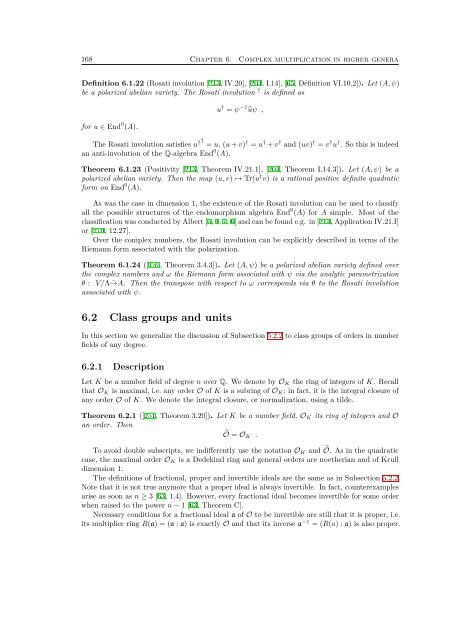here - Sites personnels de TELECOM ParisTech - Télécom ParisTech
here - Sites personnels de TELECOM ParisTech - Télécom ParisTech
here - Sites personnels de TELECOM ParisTech - Télécom ParisTech
You also want an ePaper? Increase the reach of your titles
YUMPU automatically turns print PDFs into web optimized ePapers that Google loves.
168 Chapter 6. Complex multiplication in higher generaDefinition 6.1.22 (Rosati involution [213, IV.20], [204, I.14], [65, Définition VI.10.2]). Let (A, ψ)be a polarized abelian variety. The Rosati involution † is <strong>de</strong>fined asfor u ∈ End 0 (A).u † = ψ −1 ûψ ,The Rosati involution satisfies u †† = u, (u + v) † = u † + v † and (uv) † = v † u † . So this is in<strong>de</strong>edan anti-involution of the Q-algebra End 0 (A).Theorem 6.1.23 (Positivity [213, Theorem IV.21.1], [204, Theorem I.14.3]). Let (A, ψ) be apolarized abelian variety. Then the map (u, v) ↦→ Tr(u † v) is a rational positive <strong>de</strong>finite quadraticform on End 0 (A).As was the case in dimension 1, the existence of the Rosati involution can be used to classifyall the possible structures of the endomorphism algebra End 0 (A) for A simple. Most of theclassification was conducted by Albert [5, 4, 7, 6] and can be found e.g. in [213, Application IV.21.I]or [270, 12.27].Over the complex numbers, the Rosati involution can be explicitly <strong>de</strong>scribed in terms of theRiemann form associated with the polarization.Theorem 6.1.24 ([159, Theorem 3.4.3]). Let (A, ψ) be a polarized abelian variety <strong>de</strong>fined overthe complex numbers and ω the Riemann form associated with ψ via the analytic parametrizationθ : V/Λ ˜→A. Then the transpose with respect to ω corresponds via θ to the Rosati involutionassociated with ψ.6.2 Class groups and unitsIn this section we generalize the discussion of Subsection 5.2.2 to class groups of or<strong>de</strong>rs in numberfields of any <strong>de</strong>gree.6.2.1 DescriptionLet K be a number field of <strong>de</strong>gree n over Q. We <strong>de</strong>note by O K the ring of integers of K. Recallthat O K is maximal, i.e. any or<strong>de</strong>r O of K is a subring of O K ; in fact, it is the integral closure ofany or<strong>de</strong>r O of K. We <strong>de</strong>note the integral closure, or normalization, using a til<strong>de</strong>.Theorem 6.2.1 ([251, Theorem 3.20]). Let K be a number field, O K its ring of integers and Oan or<strong>de</strong>r. ThenÕ = O K .To avoid double subscripts, we indifferently use the notation O K and Õ. As in the quadraticcase, the maximal or<strong>de</strong>r O K is a De<strong>de</strong>kind ring and general or<strong>de</strong>rs are noetherian and of Krulldimension 1.The <strong>de</strong>finitions of fractional, proper and invertible i<strong>de</strong>als are the same as in Subsection 5.2.2.Note that it is not true anymore that a proper i<strong>de</strong>al is always invertible. In fact, counterexamplesarise as soon as n ≥ 3 [63, 1.4]. However, every fractional i<strong>de</strong>al becomes invertible for some or<strong>de</strong>rwhen raised to the power n − 1 [63, Theorem C].Necessary conditions for a fractional i<strong>de</strong>al a of O to be invertible are still that it is proper, i.e.its multiplier ring R(a) = (a : a) is exactly O and that its inverse a −1 = (R(a) : a) is also proper.
















